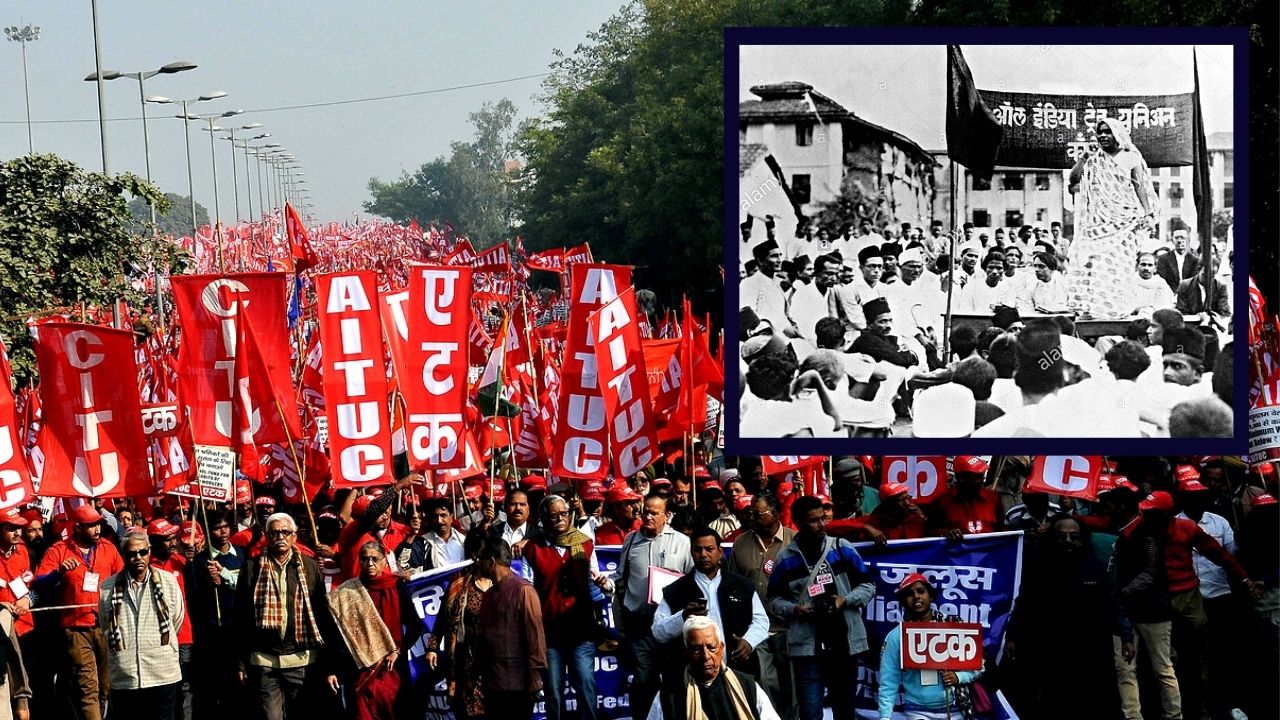The first trade union of India, for which the ideas were put forward by Bal Gangadhar Tilak, was formally established on 31 October 1920 by freedom fighters like Lala Lajpat Rai and Joseph Baptistawas, with no political affiliation.
After completing a hundred years on October 31st, India’s trade union movement is facing numerous challenges due to the changing nature of work and industry.
A senior leader of All India Trade Union Congress, Ramendra Kumar said, “We are facing the toughest time now and there is nothing I can tell you concretely on how to overcome it right away.”
Changing Nature Of Work: A Threat To Traditional Unions
The difficulties arise out of the fact that we, as a society, are witnessing rapid changes in the economy. From the inception of trade unions to this day, a lot of change has happened, for example, the service sector has become the fastest-growing sector in the economy and contributes to half of India’s GDP.
The need for trade unions in the service sector is minuscule.
Another issue faced by unions is their approach to problem-solving. With the change in time, the nature of work has become more digital and advanced, meanwhile, trade unions are stuck with their traditional methods of doing things.
According to the experts and stakeholders, unless unions change their tactics, innovate, and adopt evidence instead of emotions, it will be difficult for them to survive.
Also Read: The Pandemic Has Put A Highlight On It, But What Rights Do Migrant Workers Actually Have?
K. R. Shyam Sundar, a labour economist said, “Trade unions in India are not in sync with the changing workspace. They are doing a lot of work but are still driven by emotions and ideologies. Their argument is loud but is not backed by evidence. Do you see a vision document from a trade union or a whitepaper on the future of work? No. This is where the state and employers have fixed them and countered them through evidence.”
According to Sunder, “working-class need trade unions but they want unions which are abreast of real-time developments, tech-savvy and speak the language of the common man. A modern dynamic, trade union movement led by young leaders is the need of the hour, not a top-down system led by old leaders who are finding it tough to accept reality.”
In September 2020, the Rajya Sabha approved three bills on social security, industrial relations, and occupational safety. These laws are highly instrumental in making it easier for companies to employ and fire workers, reduce the ability of unions to strike and allow companies to directly hire fixed-time workers making business easier.
Union leaders rebuked the changes as a weakening of the rights and protections afforded to workers.
Industrial desire to outsource labour and a lack of permanent jobs are also a major threat to unions.
Trade unions also feel that they are consistently being stripped of their power by the state and capitalists alike.
With the lack of modern measures, absence of young leaders and the constant pressure from the state and capitalists, the trade unions are facing the danger of near-extinction or being dispensable at the very least.
What Do Different Trade Unions Concur In This Situation?
According to the report by Livemint, trade unions across political affiliations agree that the fight will shift from the physical to the digital, mass movements will become targeted strikes to seek negotiated results, and the knowledge of changing jobs and the need of the Industry 4.O will empower their strategy and fight for their rights, rather than just mass street fights.
Amrajeet Kaur, secretary-general of AITUC, said that “We know we are in 2020 and not in 1920. The state and the employers are against us, and they will do everything to dismantle us. What we need to do is go back to our roots and work grounds up.”
Centre for Indian Trade Unions’ national secretary A.R. Sindhu stated that “Adoption of technology for mobilization, outreach is a must. We have started doing it. The second, the unions are now shifting gear from being top-down to bottom-up. During the lockdown, the success of coal workers strikes and defence factory workers strike told us that it’s the regional leaders or sectoral leaders who will increasingly help the trade union movement to survive and thrive is a tough environment. The slow death of public sector companies has harmed the unions but off late, informal workers are joining the movement. The grass-roots movement, we believe, will now become stronger and push for workers welfare and here technology will play a big role.”
RSS chief Mohan Bhagwat was recorded announcing to Bharatiya Mazdoor Sangh (BMS) functionaries that “Everyone in the country should get justice. For this purpose, new ways (of trade union works) need to be designed according to the changes in the time.”
Trade unions are necessary for the protection of labour rights. They work in order to safeguard wage workers against capitalist greed.
Workers are exploited by business owners in order to derive more profit from sales. Low wages, extensive workload, no safeguard against being fired are a few examples of how labourers are exploited.
Due to the changing nature of work, it becomes crucial for them to adapt and modernize. If unions strategize accordingly, they will always be integral to the economy in order to represent the working class.
Image Credits: Google Images
Sources: Livemint, The Hindu, The Indian Express
Find The Blogger: @MNtweeting
This post is tagged under: Trade union, economy, working sector, labour laws, modern technology, digital age, CITU, AITUC, GDP, capitalists, business, centre, government, outsource labour, extinction
Other Recommendations:
Experts Predict What Else Could Go Wrong In The Economy Before 2020 Ends
































